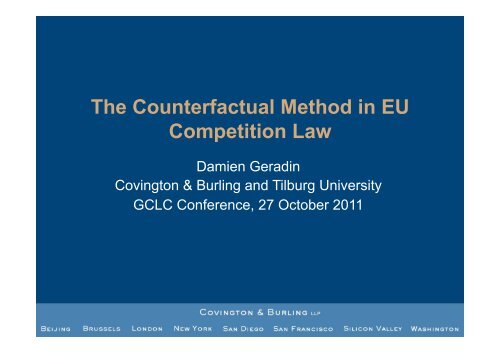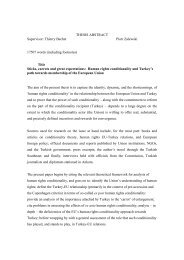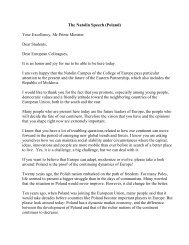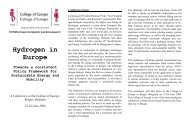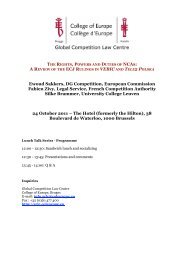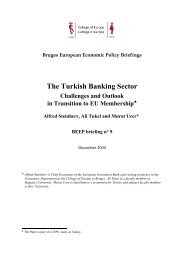D. Geradin - The Counterfactual Method in EU Competition Law
D. Geradin - The Counterfactual Method in EU Competition Law
D. Geradin - The Counterfactual Method in EU Competition Law
Create successful ePaper yourself
Turn your PDF publications into a flip-book with our unique Google optimized e-Paper software.
<strong>The</strong> <strong>Counterfactual</strong> <strong>Method</strong> <strong>in</strong> <strong>EU</strong><br />
<strong>Competition</strong> <strong>Law</strong><br />
Damien <strong>Gerad<strong>in</strong></strong><br />
Cov<strong>in</strong>gton & Burl<strong>in</strong>g and Tilburg University<br />
GCLC Conference, 27 October 2011
What is the <strong>Counterfactual</strong> <strong>Method</strong>?<br />
• <strong>Counterfactual</strong>s can be used to assess the effects of an event.<br />
<strong>The</strong>y describes the world <strong>in</strong> the absence of (or “but for”) that<br />
event<br />
• First trace of the counterfactual method can be found <strong>in</strong> Société<br />
Technique M<strong>in</strong>ière (1966) <strong>in</strong> which the ECJ <strong>in</strong>dicated that for an<br />
agreement between competitor to be caught under Article 101 it<br />
is:<br />
– “necessary to f<strong>in</strong>d that those factors are present which show<br />
that competition has <strong>in</strong> fact been prevented or restricted or<br />
distorted to an appreciable extent. <strong>The</strong> competition <strong>in</strong><br />
question must be understood with<strong>in</strong> the actual context <strong>in</strong><br />
which it would occur <strong>in</strong> the absence of the agreement <strong>in</strong><br />
dispute”.<br />
2
Use of the <strong>Counterfactual</strong> <strong>Method</strong><br />
• Until recently, this method was essentially conf<strong>in</strong>ed to the area<br />
merger control<br />
• Under Articles 101 and 102 TF<strong>EU</strong>, the Commission and the <strong>EU</strong><br />
Courts <strong>in</strong>itially adopted a “form-based” approach<br />
• Because the aim of the counterfactual technique is to analyse<br />
the effects of a given event it had little relevance under the formbased<br />
approach<br />
• In recent years the Commission has transitioned towards an<br />
effects-based approach. <strong>The</strong> modernisation of <strong>EU</strong> antitrust<br />
enforcement caused a renewed <strong>in</strong>terest <strong>in</strong> the counterfactual<br />
technique. <strong>Counterfactual</strong>s are discussed <strong>in</strong> various Article 101<br />
guidel<strong>in</strong>es and <strong>in</strong> the Article 102 Guidance Paper<br />
3
Ex ante vs Ex post <strong>Counterfactual</strong>s<br />
• In this presentation, I dist<strong>in</strong>guish between:<br />
– ex ante counterfactuals (merger control and Article<br />
101 self-assessment): <strong>The</strong>se counterfactuals are<br />
relatively easy to establish because they are<br />
usually based on the status quo ante; and<br />
– ex post counterfactuals (<strong>in</strong>vestigations under<br />
Articles 101 and 102, damages litigation): <strong>The</strong>se<br />
counterfactuals are more difficult to build because<br />
they are <strong>in</strong>tr<strong>in</strong>sically speculative<br />
4
Ex ante <strong>Counterfactual</strong>s:<br />
Alternative Future<br />
• In our paper, my co-author and I focus on the<br />
use of the counterfactual method under <strong>EU</strong><br />
merger control rules and <strong>in</strong> ex ante control<br />
and self-assessment under Article 101 TF<strong>EU</strong><br />
• We also demonstrate that while the status<br />
quo ante constitutes the default counterfactual<br />
<strong>in</strong> these procedures, the Commission is<br />
gradually adopt<strong>in</strong>g a more dynamic and<br />
forward-look<strong>in</strong>g approach towards the<br />
counterfactual <strong>in</strong> merger control cases<br />
5
Ex ante <strong>Counterfactual</strong> <strong>in</strong> <strong>EU</strong> Merger<br />
Control: <strong>The</strong> Static Approach<br />
• <strong>The</strong> standard merger control counterfactual is the<br />
status quo ante, i.e. the situation that prevails at the<br />
time when the Commission reviews the merger<br />
– This approach is illustrated by the use of analytical<br />
tools such as the HHI, which is based on the<br />
parties’ and competitors’ market shares and allows<br />
the Commission to compare the level of market<br />
concentration before and after the transaction<br />
– <strong>The</strong> HHI reflects a static vision of the<br />
counterfactual: <strong>The</strong> Commission assumes that <strong>in</strong><br />
the absence of the transaction, the market will<br />
rema<strong>in</strong> unchanged<br />
6
Ex ante <strong>Counterfactual</strong> <strong>in</strong> <strong>EU</strong> Merger<br />
Control: <strong>The</strong> Dynamic Approach<br />
• <strong>The</strong> Commission has acknowledged that the status quo ante may<br />
not always constitute the relevant counterfactual. It is sometimes<br />
necessary to take <strong>in</strong>to account certa<strong>in</strong> future events that are likely<br />
to take place <strong>in</strong> the absence of the transaction<br />
• Article 9 of the EMCR:<br />
“In most cases the competitive conditions exist<strong>in</strong>g at the time<br />
of the merger constitute the relevant comparison for<br />
evaluat<strong>in</strong>g the effects of a merger. However, <strong>in</strong> some<br />
circumstances, the Commission may take <strong>in</strong>to account future<br />
changes to the market that can reasonably be predicted. It<br />
may, <strong>in</strong> particular, take account of the likely entry or exit of<br />
firms if the merger did not take place when consider<strong>in</strong>g what<br />
constitutes the relevant comparison”<br />
7
Dynamic counterfactual: Illustrations<br />
• Fail<strong>in</strong>g firm defence: <strong>The</strong> counterfactual is no longer<br />
the status quo ante: Rather, it is an alternative future<br />
<strong>in</strong> which the target disappears from the relevant<br />
market for reasons unrelated to the merger<br />
• Other example:<br />
– In Lufthansa/Austrian Airl<strong>in</strong>es, the Commission<br />
concluded that <strong>in</strong> the absence of the transaction,<br />
the target would have probably been acquired by<br />
Air France-KLM. <strong>The</strong> Commission therefore<br />
compared the effects of the notified transaction<br />
with those of a hypothetical acquisition of Austrian<br />
Airl<strong>in</strong>es by Air France<br />
8
Ex ante <strong>Counterfactual</strong> under Article<br />
101 TF<strong>EU</strong><br />
• Guidel<strong>in</strong>es on Horizontal Agreements suggest a three-step analysis:<br />
– Parties need to determ<strong>in</strong>e whether the agreement restricts<br />
competition by its object<br />
– If the agreement’s object is not anti-competitive, it is necessary to<br />
exam<strong>in</strong>e its effects on competition<br />
• <strong>The</strong> parties should use the counterfactual method and compare<br />
the agreement’s potential effects with the situation that would<br />
arise <strong>in</strong> the absence of the agreement<br />
– If the parties conclude that their agreement falls under Article<br />
101(1), they should consider whether it can be exempted pursuant<br />
to Article 101(3) because it generates efficiency ga<strong>in</strong>s<br />
• This exam<strong>in</strong>ation also <strong>in</strong>volves a counterfactual analysis as the<br />
parties need to consider whether similar efficiencies can be<br />
achieved <strong>in</strong> the absence of the agreement<br />
9
<strong>Counterfactual</strong> under Article 101<br />
TF<strong>EU</strong> : Static v. Dynamic Approach<br />
• <strong>The</strong> default counterfactual under Article 101(1) is the status quo<br />
ante, i.e., the situation that prevails at the time when the parties<br />
are plann<strong>in</strong>g to enter <strong>in</strong>to an agreement<br />
• <strong>The</strong> counterfactual should also <strong>in</strong>corporate the events that are<br />
likely to happen <strong>in</strong> the near future <strong>in</strong> the absence of the<br />
agreement, for <strong>in</strong>stance whether the parties would compete with<br />
each other <strong>in</strong> the absence of the agreement<br />
• But <strong>EU</strong> Courts will not allow mere speculation. See European<br />
Night Services where the GC ruled that the Commission’s<br />
counterfactual (which contemplated operators compet<strong>in</strong>g with<br />
ENS) was based on “a hypothesis unsupported by any evidence<br />
or any analysis of the structures of the relevant market from<br />
which it might be concluded that it represented a real, concrete<br />
possibility”.<br />
10
Ex post <strong>Counterfactual</strong>:<br />
Alternative Past<br />
• In ex post <strong>in</strong>vestigations, the Commission<br />
needs to adopt the opposite perspective and<br />
consider an alternative past: It needs to<br />
imag<strong>in</strong>e what would have happened <strong>in</strong> the<br />
absence of the alleged <strong>in</strong>fr<strong>in</strong>gement<br />
• This exercise is <strong>in</strong>tr<strong>in</strong>sically speculative as it is<br />
based on a hypothetical and has to consider<br />
one or several scenarios that have never<br />
occurred<br />
11
Ex post <strong>Counterfactual</strong> <strong>Method</strong>s:<br />
Analytical <strong>Method</strong>s<br />
• <strong>The</strong> most important analytical methods that<br />
can be used to develop an ex post<br />
counterfactual rely either on comparators or<br />
on economic modell<strong>in</strong>g:<br />
– First, the Commission can use comparator-based<br />
methods tak<strong>in</strong>g the data (prices, volumes, etc.) <strong>in</strong> the<br />
unaffected period or on the unaffected markets as an<br />
<strong>in</strong>dication of the “but for” scenario<br />
– Second, the Commission can build economic models<br />
simulat<strong>in</strong>g the likely market outcome that would have<br />
occurred without the <strong>in</strong>fr<strong>in</strong>gement<br />
12
Ex Post <strong>Counterfactual</strong> <strong>in</strong> Article 101<br />
TF<strong>EU</strong> Cases (1)<br />
• <strong>The</strong> counterfactual method is rarely used <strong>in</strong> ex post<br />
<strong>in</strong>vestigations under Article 101 for the follow<strong>in</strong>g reasons:<br />
– <strong>The</strong> counterfactual method is only relevant to restrictions by<br />
effect s<strong>in</strong>ce restrictions by object are essentially per se<br />
illegal. In recent years, the vast majority of Article 101<br />
<strong>in</strong>vestigations <strong>in</strong>itiated by the Commission have related to<br />
<strong>in</strong>fr<strong>in</strong>gements by object, such as hard core cartels<br />
– S<strong>in</strong>ce the adoption of Regulation 1/2003, the parties are<br />
required to perform an ex ante self-assessment of horizontal<br />
and vertical agreements that may potentially fall under Article<br />
101. <strong>The</strong> Commission will <strong>in</strong>itiate an ex post <strong>in</strong>vestigation<br />
only if it considers that the self-assessment has not been<br />
correctly performed<br />
13
Ex Post <strong>Counterfactual</strong> <strong>in</strong> Article 101<br />
Cases (2)<br />
• In order to engage <strong>in</strong> counterfactual analysis, the Commission<br />
can use a variety of techniques:<br />
– Demonstrate the anticompetitive effects of a given agreement by<br />
compar<strong>in</strong>g prices that prevail on the relevant market with prices on a<br />
comparable product/geographic market that is not affected by the<br />
agreement. But regression analysis may be needed to control for<br />
exogenous factors<br />
– Simulate counterfactual market outcomes on the basis of models.<br />
Models range from monopoly to perfect competition with<br />
<strong>in</strong>termediate models (such as Cournot and Bertrand models)<br />
– F<strong>in</strong>ally, the Commission can also use the cost-based method, which<br />
estimates the level of prices that would have emerged absent the<br />
<strong>in</strong>fr<strong>in</strong>gement by calculat<strong>in</strong>g the relevant firm’s production costs per<br />
unit and add<strong>in</strong>g a mark-up represent<strong>in</strong>g a “reasonable” profit <strong>in</strong> the<br />
non-<strong>in</strong>fr<strong>in</strong>gement scenario<br />
14
<strong>Counterfactual</strong> <strong>in</strong> Article 102 Cases: From<br />
form- to effects-based approach<br />
• <strong>The</strong> Commission and the <strong>EU</strong> Courts have traditionally<br />
adopted a “form-based” approach to abuses of<br />
dom<strong>in</strong>ance and, as a result, paid little attention to the<br />
effects of alleged abuses. As long as the form-based<br />
approach prevailed, the counterfactual technique had<br />
little relevance under Article 102<br />
• However, <strong>in</strong> recent years the Commission began to<br />
gradually shift towards an “effects-based” approach<br />
notably with the adoption of the Guidance Paper<br />
15
<strong>The</strong> <strong>Counterfactual</strong> <strong>in</strong> the Article 102<br />
Guidance Paper<br />
• Paragraph 21 of the Guidance Paper states<br />
that:<br />
“This assessment will usually be made by<br />
compar<strong>in</strong>g the actual or likely future situation <strong>in</strong> the<br />
relevant market (with the dom<strong>in</strong>ant undertak<strong>in</strong>g’s<br />
conduct <strong>in</strong> place) with an appropriate<br />
counterfactual, such as the simple absence of the<br />
conduct <strong>in</strong> question or with another realistic<br />
alternative scenario, hav<strong>in</strong>g regard to established<br />
bus<strong>in</strong>ess practices”<br />
16
Not every effects-based analysis is<br />
based on a proper counterfactual<br />
• In the Telekomunikacja Polska refusal to supply case, the<br />
Commission’s analysis of the conduct’s effects is based on a<br />
series of comparators:<br />
– Anti-competitive effects: Evidence of foreclosure is largely<br />
based on statements from competitors and on the analysis of<br />
failed negotiations<br />
– Consumer harm: <strong>The</strong> Commission used a comparator-based<br />
approach to demonstrate that broadband penetration <strong>in</strong><br />
Poland was low, retail broadband prices were high, etc.<br />
• <strong>The</strong> Telekomunikacja Polska case shows that while the<br />
Commission is eager to <strong>in</strong>clude some effects-based analysis <strong>in</strong> its<br />
Article 102 decisions, it is generally unwill<strong>in</strong>g to go beyond a fairly<br />
simplistic comparator-based approach and consider more<br />
elaborate counterfactuals<br />
17
<strong>The</strong> <strong>Counterfactual</strong> Used as a<br />
Defence by Dom<strong>in</strong>ant Firms<br />
• Dom<strong>in</strong>ant firm can use the counterfactual <strong>in</strong><br />
Article102 <strong>in</strong>vestigations:<br />
– First, the dom<strong>in</strong>ant firm can use the counterfactual<br />
to demonstrate that the theory of harm developed<br />
by the Commission and/or compla<strong>in</strong>ants does not<br />
hold. Exs: Qualcomm, Microsoft Internet Explorer<br />
– Second, counterfactuals can be used to<br />
demonstrate the lack of anti-competitive effects of<br />
a given dom<strong>in</strong>ant firm’s conduct<br />
– F<strong>in</strong>ally, counterfactuals can also be used to<br />
demonstrate the lack of consumer harm<br />
18
Use of <strong>Counterfactual</strong>s <strong>in</strong> Quantification<br />
of Harm <strong>in</strong> Actions for Damages (1)<br />
• In Courage v. Crehan, the ECJ held that the full<br />
effectiveness of Article 101 “would be put at risk if it<br />
were not open to any <strong>in</strong>dividual to claim damages for<br />
loss caused to him by a contract or by conduct liable<br />
to restrict or distort competition”<br />
• In June 2011, the Commission published a draft<br />
Guidance Paper on quantify<strong>in</strong>g harm <strong>in</strong> actions for<br />
damages based on breaches of Articles 101 or 102.<br />
<strong>The</strong> purpose of the Damages Guidance Paper is “to<br />
place at the disposal of courts and parties to damages<br />
actions economic and practical <strong>in</strong>sights that may be of<br />
use when national rules and practices are applied”<br />
19
Use of <strong>Counterfactual</strong>s <strong>in</strong> Quantification<br />
of Harm <strong>in</strong> Actions for Damages (2)<br />
• <strong>The</strong> difference between the use of counterfactual to<br />
determ<strong>in</strong>e whether Articles 101 and/or 102 TF<strong>EU</strong><br />
have been breached and the use of counterfactual for<br />
the assessment of damages is that <strong>in</strong> the former case<br />
there is no need for the relevant authority to<br />
determ<strong>in</strong>e the exact level of the damages caused by<br />
the <strong>in</strong>fr<strong>in</strong>gement<br />
• <strong>The</strong> methods used for counterfactual analysis are,<br />
however, similar to those that can be used to assess<br />
whether a breach of Articles 101 and/or 102 TF<strong>EU</strong><br />
has been committed<br />
20
Economic variables to be considered<br />
• <strong>The</strong> type of harm for which the <strong>in</strong>jured person<br />
seeks compensation determ<strong>in</strong>es which k<strong>in</strong>d of<br />
economic variables need to be considered<br />
– In a cartel lead<strong>in</strong>g to higher prices for customers, a non<strong>in</strong>fr<strong>in</strong>gement<br />
price (or “but for” price) will need to be<br />
estimated to have a reference po<strong>in</strong>t for compar<strong>in</strong>g it with the<br />
price actually paid by these customers<br />
– In an abuse of dom<strong>in</strong>ance case <strong>in</strong> which the dom<strong>in</strong>ant firm’s<br />
rivals were foreclosed from competition, the profits lost by<br />
these competitors may be measured by compar<strong>in</strong>g their<br />
actual turnover and profit marg<strong>in</strong>s with the turnover and profit<br />
marg<strong>in</strong>s they would have likely generated but for the<br />
<strong>in</strong>fr<strong>in</strong>gement<br />
21
Measurement difficulties<br />
• Measurements can be difficult as one can never be certa<strong>in</strong> just<br />
what would have happened <strong>in</strong> the “but for” world<br />
• <strong>The</strong> typical method is to pick some contemporaneous or past<br />
basel<strong>in</strong>e where or when markets or firms were not affected by the<br />
anticompetitive conduct and assume that any difference between<br />
the basel<strong>in</strong>e and reality was caused by the anticompetitive<br />
conduct. Contemporaneous or past basel<strong>in</strong>es may be <strong>in</strong>accurate<br />
because of different costs or demand, because they were also<br />
affected by the same anticompetitive conduct, or because firms<br />
differ <strong>in</strong> their efficiency or other features. <strong>The</strong>se differences can,<br />
however, be controlled for by econometric analysis<br />
• As a result claimants must often base their cases on expert<br />
projections about what prices or profits would have been but for<br />
the anticompetitive conduct <strong>in</strong> a way that accounts for differences<br />
between the “but for” world and the posited basel<strong>in</strong>e<br />
22
Conclusions<br />
• <strong>Counterfactual</strong> analysis is a very useful analytical method<br />
<strong>in</strong> competition cases<br />
• It seeks to analyse the effects of a given transaction,<br />
agreement or conduct<br />
• Ex ante counterfactuals require the development of an<br />
alternative future, whereas ex post counterfactuals require<br />
the development of an alternative past<br />
• Economists have developed a variety of tools to assist<br />
lawyers <strong>in</strong> counterfactual analysis<br />
• Not every effects-based analysis rely on a proper<br />
counterfactual<br />
• <strong>The</strong> use of proper counterfactuals <strong>in</strong> Articles and 102<br />
cases is still relatively rare<br />
23


